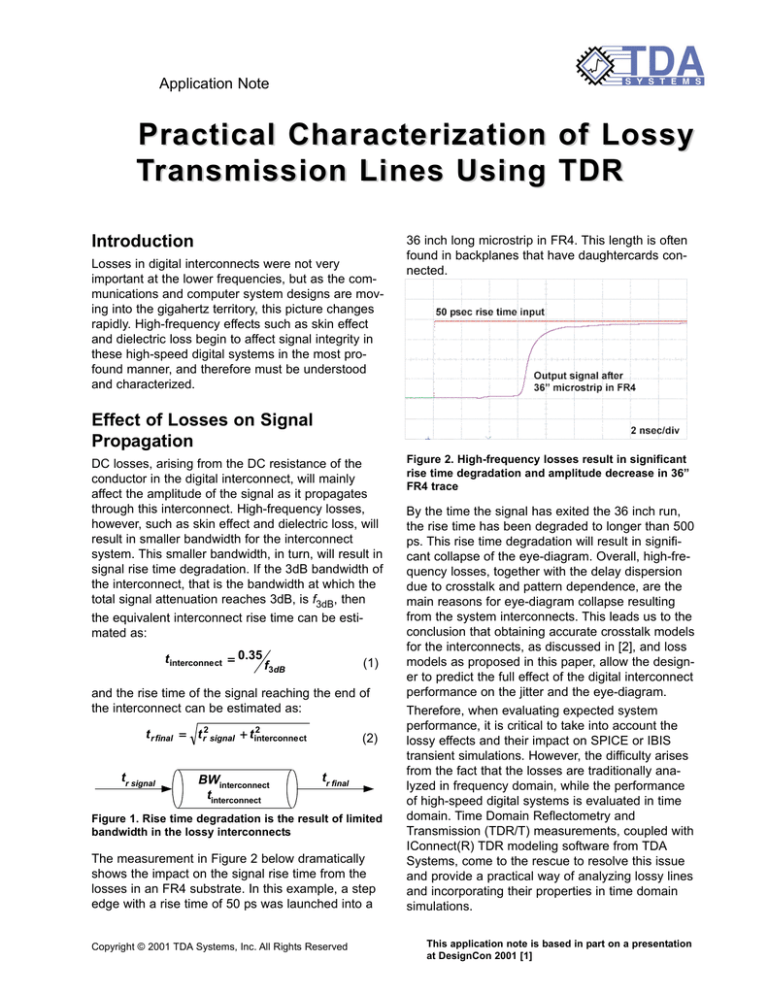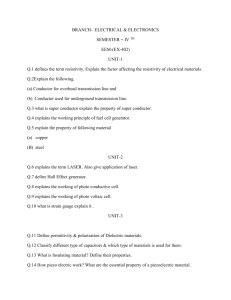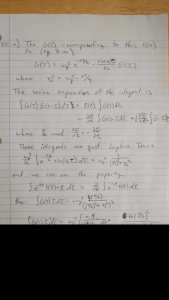
Application Note
Practical Characterization of Lossy
Transmission Lines Using TDR
Introduction
Losses in digital interconnects were not very
important at the lower frequencies, but as the communications and computer system designs are moving into the gigahertz territory, this picture changes
rapidly. High-frequency effects such as skin effect
and dielectric loss begin to affect signal integrity in
these high-speed digital systems in the most profound manner, and therefore must be understood
and characterized.
36 inch long microstrip in FR4. This length is often
found in backplanes that have daughtercards connected.
Effect of Losses on Signal
Propagation
DC losses, arising from the DC resistance of the
conductor in the digital interconnect, will mainly
affect the amplitude of the signal as it propagates
through this interconnect. High-frequency losses,
however, such as skin effect and dielectric loss, will
result in smaller bandwidth for the interconnect
system. This smaller bandwidth, in turn, will result in
signal rise time degradation. If the 3dB bandwidth of
the interconnect, that is the bandwidth at which the
total signal attenuation reaches 3dB, is f3dB, then
the equivalent interconnect rise time can be estimated as:
t interconne ct = 0.35
(1)
f3dB
and the rise time of the signal reaching the end of
the interconnect can be estimated as:
2
t r final = t r2 signal + t interconne
ct
tr signal
BWinterconnect
tinterconnect
(2)
tr final
Figure 1. Rise time degradation is the result of limited
bandwidth in the lossy interconnects
The measurement in Figure 2 below dramatically
shows the impact on the signal rise time from the
losses in an FR4 substrate. In this example, a step
edge with a rise time of 50 ps was launched into a
Copyright © 2001 TDA Systems, Inc. All Rights Reserved
Figure 2. High-frequency losses result in significant
rise time degradation and amplitude decrease in 36”
FR4 trace
By the time the signal has exited the 36 inch run,
the rise time has been degraded to longer than 500
ps. This rise time degradation will result in significant collapse of the eye-diagram. Overall, high-frequency losses, together with the delay dispersion
due to crosstalk and pattern dependence, are the
main reasons for eye-diagram collapse resulting
from the system interconnects. This leads us to the
conclusion that obtaining accurate crosstalk models
for the interconnects, as discussed in [2], and loss
models as proposed in this paper, allow the designer to predict the full effect of the digital interconnect
performance on the jitter and the eye-diagram.
Therefore, when evaluating expected system
performance, it is critical to take into account the
lossy effects and their impact on SPICE or IBIS
transient simulations. However, the difficulty arises
from the fact that the losses are traditionally analyzed in frequency domain, while the performance
of high-speed digital systems is evaluated in time
domain. Time Domain Reflectometry and
Transmission (TDR/T) measurements, coupled with
IConnect(R) TDR modeling software from TDA
Systems, come to the rescue to resolve this issue
and provide a practical way of analyzing lossy lines
and incorporating their properties in time domain
simulations.
This application note is based in part on a presentation
at DesignCon 2001 [1]
Loss Mechanisms
In presence of losses, the classic equation for the
characteristic impedance of a transmission line:
Z = L
C
(3)
where L and C are inductance and capacitance of
the line per unit length, changes to:
R + jω L
Z =
G + jω C
(4)
where R and G are resistance of transmission line
conductor and conductance of the dielectric per unit
length, which may vary with frequency. The corresponding equivalent circuit can be described as follows:
R∆l
L∆l
C∆l
G∆l
Figure 3. Equivalent circuit for a lossy transmission
line segment includes conductor resistance and
dielectric conductance, which may be frequency
dependent. ∆l is the length of the transmission line
segment
Inductance may vary with frequency as well, but as
we will see, one can account for it in the resistance
term.
Skin Effect: Series Resistance
Series resistance consists of the DC resistance
term RDC and the high-frequency skin effect term
RAC [3]. The DC resistance term can be calculated
directly from the geometry of the conductor as:
ρ
RDC =
(5)
tw
where ρ is the DC resistivity of the conductor metal,
t is the thickness and w is the width of the conductor.
RAC increases with frequency due to the current
crowding on the outside surface of the conductor at
higher frequencies. The area close to the surface
that continues to support the flow of the current at
higher frequencies is called the skin depth, and is
determined as:
(6)
1
δ =
σπµ f
where σ is the conductivity of the metal, µ is its
magnetic permittivity, and f is the frequency at
which the skin depth is calculated. If we now use
equation (5) to compute the AC resistance, and
2
substitute δ from equation (6) to calculate the crosssection of the conductor at higher frequency, we will
discover that the skin effect resistance is proportional to the square root of frequency, and the total conductor resistance at frequency can be calculated as:
(7)
R (f ) = R + R ⋅ f
DC
AC
For the same reasons that resistance changes with
frequency, inductance will too. As the current
crowds to the outside “skin” of the conductor at
higher frequencies, the inductance at the same frequencies decreases as follows:
R (f ) + j ω L = RDC + R AC ⋅ f ⋅ (1 + j )
(
= RDC + R AC
)
R
⋅ f + j ω L + AC
2π f
(8)
Dielectric Loss: Shunt Conductance
Dielectric loss is due to the displacement current in
the transmission line dielectric, such as FR4. If we
describe the frequency dependent complex dielectric constant as:
(9)
ε (ω ) = ε ' (ω ) + j ε ' ' (ω )
the current through the equivalent capacitor formed
by the transmission line in the dielectric with dielectric constant ε(ω) can be described as:
I =C
dV
+ Gd V
dt
(10)
where I is the current through the transmission line,
V is the voltage applied to that transmission line, C
is the transmission line capacitance per unit length,
and Gd is the dielectric conductance per unit length.
The dielectric conductance can be described using
a factor known as dielectric loss tangent or tan(δ):
Gd = ω tan(δ )C
(11)
where tan(δ) is defined as:
(12)
ε ''
tan(δ ) =
ε'
Typically, tan(δ) is constant vs. frequency within the
frequency range of interest for common high-speed
board materials today, such as FR4 or Duroid®, but
the assumption of tan(δ) being independent of frequency must be tested for each material. It is
important to note, however, that if tan(δ) is frequency independent, equation (11) indicates that the
dielectric conductivity will be linearly increasing with
frequency.
A typical tan(δ) value for Duroid®, as given in [4], is
a very small factor, about 0.005. It is typically a
small factor for most other dielectrics used today,
even FR4. As a result, skin effect will dominate the
loss and dispersion characteristics in the lower
gigahertz range, whereas the dielectric loss will
dominate in the upper gigahertz range. For example, for 1oz copper, 8-mil wide trace, εr of 3.5 and
tan(δ) of 0.02 (typical FR4 trace of about 50 Ω
impedance), the dielectric loss will begin to dominate near 1 Ghz, as shown in Figure 4.
Figure 4. For 1oz copper, 8mil wide trace, εr of 3.5
and tan((δ) of 0.02 (typical FR4 trace of about 50 Ohm
impedance), the dielectric loss will begin to dominate
near 1Ghz
Transmission Line Loss Modeling
in IConnect TDR Software
From the knowledge about loss mechanisms that
we gained in the previous section of this paper, we
conclude that if we can determine RAC and Gd, we
get the complete high frequency dispersion picture
for our interconnect.
A simple approach appears to be to use the
equations given in the previous section, or one of
the many powerful electromagnetic field solvers on
the market, and compute those parameters based
on the theoretical data. The problem with this
approach, however, is that we all know that accurate information about the dielectric constant, magnetic permittivity, resistivity and often the exact
geometry of the transmission line on the board is
not easily available. Without such information, any
loss parameter extraction will provide inaccurate
data and will not be useful for circuit simulations.
A more practical approach is to use TDR/T
measurements and extract the loss parameters
using IConnect TDR software lossy line modeling
function. With IConnect lossy line model extraction,
we start with TDR and TDT measurements on the
test vehicle, and fit the value of characteristic
impedance Z0, time delay td, tan(δ), RDC and RAC to
the measured data. IConnect software provides a
direct integrated interface to simulation tools and
allows the designer to run the SPICE or IBIS
simulation on the extracted data, and obtain an
automatic comparison between the simulation and
the previously measured TDR/T data. This is an
easier and more intuitive approach for a digital
designer than extracting these parameters from frequency domain measurements.
The first step in the extraction process is to acquire
a reference open waveform by taking a TDR of a
test fixture or test probe disconnected from the
Device Under Test (DUT). If the quality of the open
reference is poor and losses in the fixtures, probes
and cables are high, it may be difficult to extract the
interconnect loss accurately. Therefore, a designer
must pay careful attention to the fixtures, probes
and cables used in the measurement process.
These fixtures and probes ought to be either deembedded or allow the designer direct access to
the DUT. Such de-embedding is relatively easy to
use with a TDR oscilloscope.
The next step is to measure TDR and TDT data for
the DUT. Good repeatability between the reference
measurement and the DUT measurement is very
important when extracting losses.
The test vehicle DUT is a 42.5 inch long serpentine
microstrip manufactured on FR4 substrate (Figure
5). The spacing between the meander legs
was chosen so that the crosstalk is less than 1%.
It is important that the loss extraction must be performed on a DUT without significant changes in line
impedance; otherwise, the energy losses due to
reflection of the signal at discontinuities between
transmission lines of different impedance will be
overlayed on top of skin effect and dielectric losses
and will make the extraction of skin effect and
dielectric loss parameters difficult.
Figure 5. Test vehicle. Specific DUT characteristics
µm (1oz), w=120mils, εr~4.6, tan((δ)~0.02,
were: t=30µ
Z0~50 Ohm
3
The parameters extracted by IConnect for this test
vehicle are:
G = 0 S/m (fixed at 0)
RDC = 0.2 Ω/m
L = 284 nH/m
C = 123 pF/m
RAC = 6.9e-5 Ω/(m·Hz1/2)), Gd = 1.39e-11 S/(m·Hz)
These values of L and C correspond to impedance
of 46.5 Ω and delay of 6.55 ns. Delay of 6.55 ns for
42.5 inch traces gives us an effective dielectric constant of 3.4. This effective dielectric constant value
is lower than the typical one for the FR4 bulk dielectric constant, because our test vehicle conductor is
on the outer board layer, forming what is known as
microstrip line. Gd correlates to tan(δ) of 0.018. The
correlation between simulation using these results
and TDR/T measurements is shown in Figure 6.
designer with the transient time domain information
he or she needs for validating the model. The
comparison of simulated and measured data in time
domain provides an accurate visual confirmation of
the model accuracy to the designer.
It is worth noting that the effect of skin effect resistance on the overall high-frequency loss is small for
this test vehicle. It is small due to the large test
vehicle trace width, resulting in larger surface area
in the conductor where the current can continue to
flow even at higher frequencies. The dielectric loss,
on the other hand, is independent of the conductor
geometry, and depends only on the dielectric material properties. As a result, such a test vehicle is
more amenable to characterization of dielectric loss.
For a more real-world trace width of 5 mils, the skin
effect would have a more profound effect on the
overall loss in the interconnect, and we would
extract a higher value for RAC in IConnect.
The extraction process may be applied to obtain the
differential loss characteristics of the interconnect.
In that case, all the reference open, TDR and TDT
of the DUT must be acquired with the TDR oscilloscope in differential mode.
Bibliography
Figure 6. Correlation between the lossy line
simulation and TDR/T measurement in IConnect.
Lossy line data extracted in IConnect are: Z0=48 Ω,
td=6.36 ns, RDC=0.2 Ω/m, RAC=6.9e-5 Ω/(m·Hz1/2)), Gd
= 1.39e-11 S/(m·Hz), tan (δδ)= 0.018. Excellent correlation results are achieved for both reflection and
transmission measurements
The additional advantage of the IConnect TDR software lossy line modeling algorithm is that the correlation of the modeling results to measurement is
performed in time domain, providing the digital
[1] E. Bogatin, M. Resso, S. Corey, “Practical
Characterization and Analysis of Lossy
Transmission Lines,” – DesignCon 2001, Santa
Clara, CA, January 2001
[2] D. A. Smolyansky, S. D. Corey, "Characterization
of Differential Interconnects from Time Domain
Reflectometry Measurements," – Microwave
Journal, Vol. 43, No. 3, pp. 68-80 (TDA Systems
application note DIFF-1099)
[3] H. W. Johnson, M. Graham, High-Speed Digital
Design, – Prentice Hall, 1993
[4] H. Yue, K.L. Virga, J.L. Prince, “Dielectric
Constant and Loss Tangent Measurements Using a
Strip Line Fixture,” – IEEE Transactions CPMT,
Part. B, Vol. 21, November 1998
© 2001 TDA Systems, Inc. All Rights Reserved
4000 Kruse Way Pl. #2-300, Lake Oswego, OR 97035, USA
Telephone: (503) 246-2272 Fax: (503) 246-2282
E-mail: info@tdasystems.com Web site: www.tdasystems.com
The Interconnect Analysis Company™
4
LOSS-0601
Data subject to
change without notice





